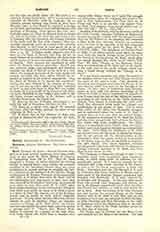

Basil, LITURGY OF Saint.—Several Oriental liturgies, or at least several anaphoras, have been attributed to the great St. Basil, Bishop of Caesarea in Cappadocia from 370 to 379. That St. Basil composed a liturgy, or rather reformed an existing liturgy, is beyond doubt, since besides the constant tradition of the Byzantine Church there are many testimonies in ancient writings to establish the fact. In a treatise on the tradition of the Divine liturgy attributed to St. Proclus, Patriarch of Constantinople (434-466), it is stated that when St. Basil noticed the slothfulness and degeneracy of men, how they were wearied by the length of the liturgy, he shortened it in order to cure their sloth (P.G., LXV, 849). More certain testimony to the existence of a liturgical text which went under the name of St. Basil is given in a letter of Peter the Deacon, one of the Scythian monks sent to Rome to settle certain dogmatic questions. Writing about the year 520 to the African bishops in exile in Sardinia, Peter, an Oriental, mentions a Liturgy of St. Basil, which was known and used throughout the entire East, and even quotes a passage from it: “Hence, also, Blessed Basil, Bishop of Caesaria, in a prayer of the holy altar, with which almost the entire East is familiar, says among other things: Grant us, O Lord, Thy strength and protection; make the evil good and preserve the just in their righteousness. For Thou canst do all things and there is no one who may oppose Thee; for when Thou desirest, Thou savest, and no one resists Thy will.” (P.L., LXV, 449.)
Leontius of Byzantium, writing about the middle of the sixth century, censures Theodore of Mopsuestia because he was not content with the liturgies handed down by the Fathers to the churches, but composed a Mass of his own, showing, thereby, no reverence either for that of the Apostles, or for that composed in the same spirit by the great St. Basil (P.G., XXVI, 1368). The Quinisext, or Trullan Council (692), in its thirty-second canon draws an argument from the written liturgy of the archbishop of the church of the Caesareans, St. Basil, whose glory has spread through the whole world (Mansi, Coll. Conc., XI, 958). Finally, in the Barberini library there is a manuscript of the latter part of the eighth, or the early part of the ninth, century which contains a Greek liturgy entitled the “Liturgy of St. Basil”.
It is not known precisely just what the nature of the Basilian reform was, nor what liturgy served as the basis of the saint’s work. Very probably he shortened and changed somewhat the liturgy of his own diocese, which was akin to the Liturgy of St. James. In later times it underwent some development, so that with our present knowledge of its history it would be almost impossible to reconstruct it as it came from the pen of the Bishop of Caesarea. According to the tradition of the Greek Orthodox Church, their liturgy is practically the work of St. Basil, due allowance being made for changes and amelioration in the course of time. This is older than either of the other two Byzantine liturgies, and is mentioned under the name of St. Basil in ancient times as if it were then the normal liturgy. Of the anaphoras attributed to St. Basil the Syriac and Armenian are probably derived from the Byzantine Greek with some modifications. The Abyssinian is a translation of the Coptic, while the Coptic, Arabic, and Greek Egyptian liturgies are substantially the same. These Egyptian anaphoras of St. Basil are different from the Caesarean or Byzantine liturgy, and do not possess all the characteristics of the Alexandrian Rite, but appear rather to be modeled on the Syrian type, so they are probably an importation into Egypt. The Greek Egyptian contains several prayers (identical with those in the Byzantine liturgy) expressly ascribed to St. Basil, and from these it may derive its title.
The Caesarean or Byzantine Liturgy is used in the countries which were evangelized from Constantinople, or which came under its influence for any considerable period. It is used, for example, by the Orthodox and Uniat Greek churches in the Orient, as well as by the Greek communities in Italy and Sicily. Translated into the Old Slavonic it is used by Orthodox and Uniat Catholics in Russia and in some parts of the Austrian Empire; translated into Georgian and Rumanian it is used respectively in Georgia and Rumania. It has also been translated into several other languages and dialects for use in the Russian dependencies and where the Russian Church has missions, as well as into Arabic for use in Syria. Since the Liturgy of St. John Chrysostom has become the normal liturgy of the Greek Church, that of St. Basil is now used only on the Sundays of Lent with the exception of Palm Sunday, on Holy Thursday and Holy Saturday, on the vigils of Christmas and of the Epiphany, and on the feast of St. Basil, which in the Greek calendar occurs on the first day of January.
The liturgy may be divided into the Mass of the catechumens and the Mass of the faithful. The first contains the prayers of the prothesis, of the antiphons, of the little entrance, and of the trisagion, the lessons, and the prayers of the ectenes and of the catechumens. The Mass of the faithful begins with the two prayers of the faithful, and contains the prayer of the great entrance, the prayer of the Offertory, which is expressly ascribed to St. Basil, the kiss of peace, the Creed, and the Anaphora. The Anaphora proper, starting with the Eucharistic Preface followed by the Sanctus, embraces the preparatory prayers for the Consecration, the Consecration itself, the Epiclesis or invocation of the Holy Ghost, the Great Intercession for the living and the dead, the Lord’s Prayer, the inclination, Elevation, Communion, thanksgiving, and dismissal.
J. F. GOGGIN

